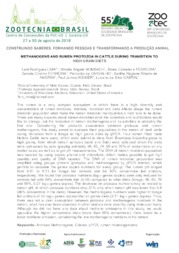Methanogens and rumen protozoa in cattle during transition to high grain diets.
Methanogens and rumen protozoa in cattle during transition to high grain diets.
Author(s): LIMA, L. R.; MOMBACH, M. A.; PEDREIRA, B. C. e; FERREIRA, D. C.; CARVALHO, P. de; AMORIM, K. R. R. de; WEIMER, P. J.; CABRAL, L. da S.
Summary: The rumen is a very complex ecosystem in which there is a high diversity and concentration of rumen microbes. Animals, microbial and diets effects shape the rumen microbial population what make the rumen microbial manipulation a hard task to be done. There are many aspects about rumen microbial what the scientists and nutritionists would like to change, but the reduction in rumen methanogens and its activities is probably the first one. Considering the probable association between protozoa and rumen methanogens, this study aimed to evaluate their populations in the rumen of beef cattle during transition from a forage to high grains diets by qPCR. Four rumen fitted male Nellore Cattle were used, which were submit to diets from Brachiaria brizantha grass to high grains, from which rumen samples (solid and fluid) were collected when the diets were composed by zero (grazing animals), 50, 60, 70, 80 and 90% of concentrate on dry matter basis, as well as to get pH measurements. The DNA of rumen microbial population was isolated by using beads, phenol and chloroform, which makes possible to get high quantity and quality of DNA isolated. The DNA of rumen microbial population was amplified using groups primers (protozoa and methanogens) by qPCR method, which permits to calculate the genes copies numbers for every group. The rumen pH ranged from 6.51 to 5.73 for forage fed animals and for 90% concentrate fed animals, respectively. We found that protozoa numbers (log10 genes copies) were only reduced for animals fed with 90% concentrate diet (4.00) compared to other diets (forage, 50, 60, 70 and 80%, 5.07 log10 genes copies). The decrease on protozoa numbers may be related to rumen pH, in which protozoa numbers drop 21% only when rumen pH was lower that 5.8 (80% concentrate in the diets). However, the methanogens numbers were higher in forage fed animals (4.40 log10 genes copies) that all grains diets (3.71 log10 genes copies). Thus, there was not a clear association between protozoa and methanogens numbers in the rumen, what has also been observed in other studies done recently using molecular tools. Although we did not have any data about methane emissions in this study, we could speculate the higher concentrate diets (more than 50% concentrate), there would be a lower methane emission, considering the low methanogens numbers in the rumen.
Publication year: 2018
Types of publication: Abstract in annals or event proceedings
Keywords: Archaea, Methanogens, Rumen microorganisms
Observation
Some of Embrapa's publications are published as ePub files. To read them, use or download one of the following free software options to your computer or mobile device. Android: Google Play Books; IOS: iBooks; Windows and Linux: Calibre.
Access other publications
Access the Agricultural Research Database (BDPA) to consult Embrapa's full library collection and records.
Visit Embrapa Bookstore to purchase books and other publications sold by Embrapa.

